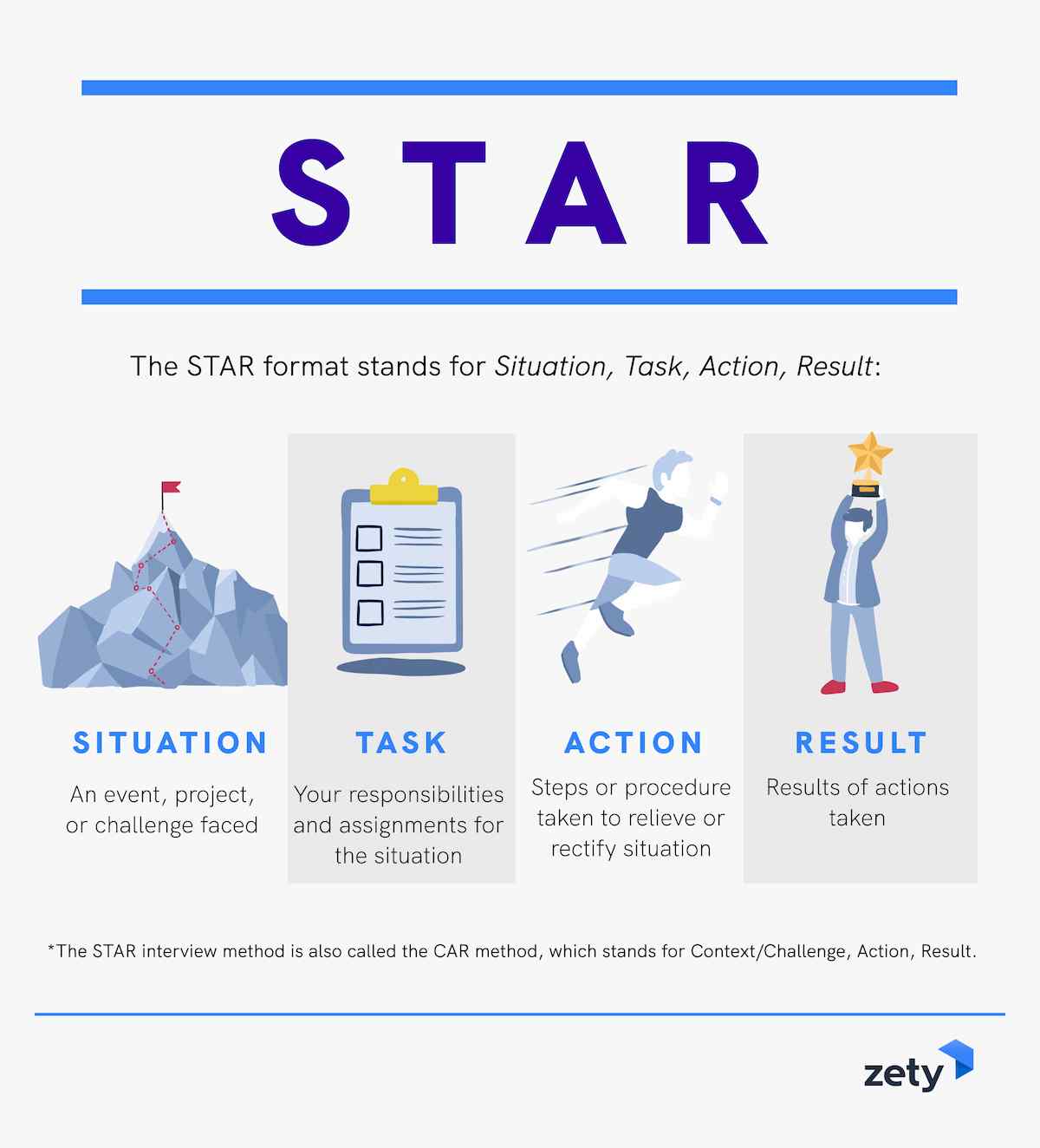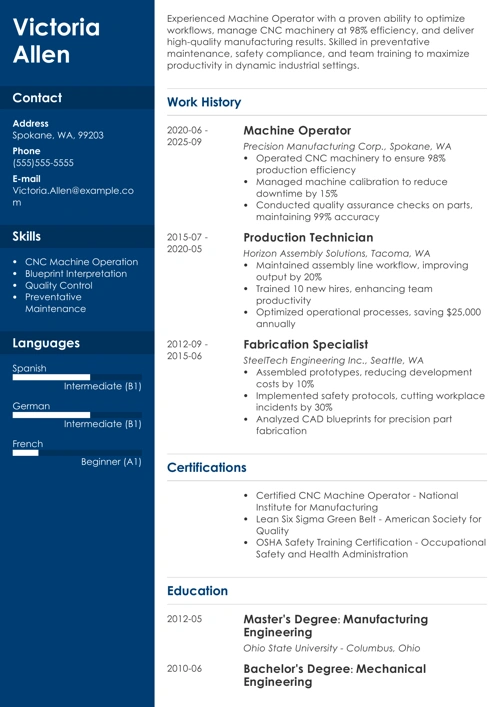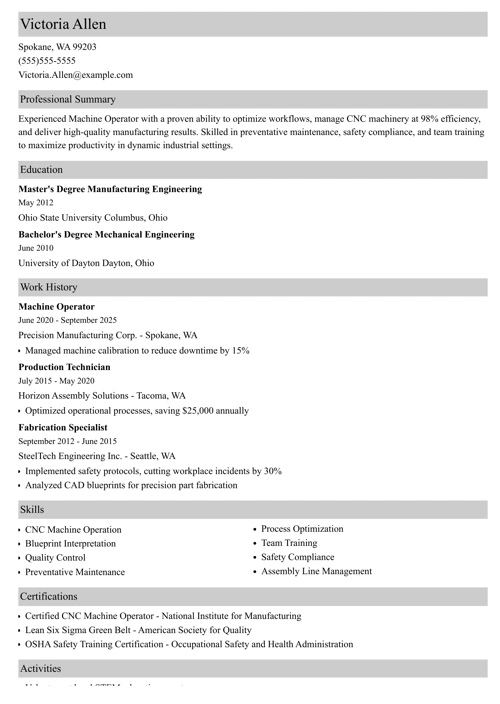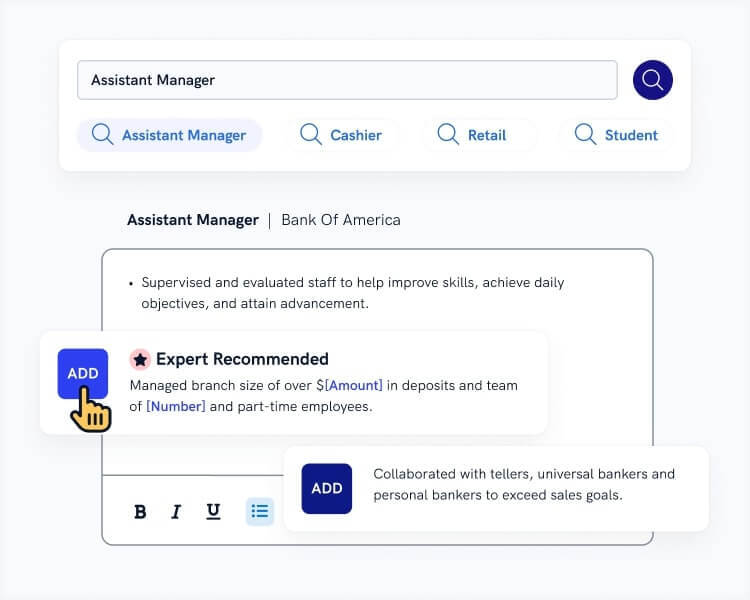What strategy should you use when answering questions at a job interview? A heads-up: fake it till you make it won’t work.
What will work is the STAR method—a special formula for moments like these: Tell me about a time when you…, Give me an example of…, or Have you ever…
Get ready to succeed at your upcoming interview with this guide on using the STAR interview method.
This guide will show you:
- What the STAR interview method is, and how to apply it in your next job interview.
- How to recognize and tackle STAR format interview.
- Over a dozen examples of professional answers for STAR questions at interviews.
Want to save time and have your resume ready in 5 minutes? Try our resume builder. It’s fast and easy to use. Plus, you’ll get ready-made content to add with one click. See 20+ resume templates and create your resume here.
Sample resume made with our builder—See more resume examples here.
One of our users, Brittanya, had this to say:
Zety really helped me create the best resume possible. It pointed out how things could be better on my existing resume and suggested many things to be re-worded or removed.
Looking for more guides to succeed in your interview? See:
- Situational Interview Questions
- Phone Interview Questions
- Common Interview Questions
- What Is Your Greatest Weakness Interview Question
- Where Do You See Yourself in 5 Years Interview Question
- Why Should We Hire You Interview Question
Now, let’s learn all about the STAR interview method:
What Is the STAR Method for Interviews?
The STAR method (Situation, Task, Action, and Result) is an interview technique best used to answer behavioral questions. Candidates often use it to explain how they handled work-related challenges. Using the STAR interview method can help you respond confidently to the recruiter’s questions.
As I’ve mentioned, the STAR stands for:
- Situation: An event, project, or challenge you faced at work.
- Task: The tasks and responsibilities you had in the situation.
- Action: Steps you took to fix or complete the task.
- Result: Results of the actions you’d taken.

Is the Star Interview Method the Only Technique for Job Interviews?
The STAR interview method is often a way to answer behavioral interview questions. But there are other, less popular methods, too. They’re CAR (Context, Action, Result) and PAR (Problem, Action, Result.) In the end, however, most experts recommend using the STAR method of interviewing.
Pro Tip: The STAR method is perfect for all aspects of the job hunt because it lets you talk about professional achievements rather than duties and responsibilities.
How to Use the STAR Interview Method to Answer Questions
Now that the brief theory about the STAR technique is behind you, you can put it into practice. That’s the surefire way to ace a job interview.
To answer an interview question using the STAR method, remember to:
- Describe the situation from your past.
- Explain what task you had to handle.
- Outline the actions you took to solve the problem.
- Highlight the results of your actions.
Let’s use this question for starters:
Tell me about a time when you performed well under enormous pressure.
Below, you’ll see a suggested answer that uses the STAR method, with each part of the answer highlighted to present the situation, task, action, and results:
STAR Interview Question and Answer
| RIGHT |
|---|
Q: Tell me about a time you performed well under enormous pressure. A: One time, at my last job, my coworker had a family emergency and needed to miss work for some time, and their super-important project was left unfinished and without a manager. My supervisor instructed me to take on the project, and with no leniency on the deadline, I had days to complete a project that originally should have taken several weeks. I requested and was granted a reduction in my weekly goals, allotting me more time to attack the special project. Regarding my weekly goals, I could delegate them evenly to some of my teammates.With the reduction in my daily goals, I could dedicate more time to the special project. This allowed me to finish it on time and with complete accuracy. My supervisor appreciated my attitude and drive, and I was given several more projects after that, along with an eventual promotion and pay raise. |
See that? It might have been a long story for an answer, but following the STAR format in an interview will give you the detailed responses your interviewer expects. And it’s not too hard to do, either. As long as you work out each step in the STAR technique in order, you’ll nail your answer and impress them while you’re at it.
Pro Tip: When using the STAR format for interviews, bring up stories where you were the main actor, and use the first person singular in your answers, like this: “I did…” rather than “We did.” Keep the focus on you.
Making a resume with our builder is incredibly simple. Follow our step-by-step guide, use ready-made content tailored to your job and have a resume ready in minutes.
When you’re done, Zety’s resume builder will score your resume and our ATS resume checker will tell you exactly how to make it better.
10 Sample STAR Interview Questions and Answers
Let’s look at a list of typical STAR questions for interviews and sample answers:
1. Tell me about a time you had a conflict at work.
| RIGHT |
|---|
| I had a disagreement with a coworker, which originated from a miscommunication. We had to discuss it and make amends to keep our work environment professional and positive. I sat down with them one day during lunch and took the initiative by apologizing for my part in the whole mess. Now, we work together well and are often praised for our impressive teamwork. |
2. Can you describe a stressful situation and how you handled it?
| RIGHT |
|---|
| At my last restaurant, I once learned about a health inspection mere hours in advance. As the head chef, I was responsible for ensuring everything was in order in the kitchen and the BOH before the inspector arrived. I quickly called in employees from the last shift to help, leaving the others available to prep for that evening’s dinner. As a result, we could ace the inspection, which was less costly in the long run compared to giving employees a few hours of overtime. |
3. Can you detail a mistake you made and how you reacted to it?
| RIGHT |
|---|
| One time, I switched the packing labels of two packages I sent to customers. I had to correct the problem without angering the clients. I called them both up and provided them with shipping labels with the correct addresses while offering each of them a small gift certificate to use on a future order. The customers not only helped me fix my mistake but were both satisfied and will return and shop again. |
4. Tell me about a time you performed well under enormous pressure.
| RIGHT |
|---|
| At my last job, my coworker needed to miss work for some time, and their project needed a manager. My supervisor instructed me to take on the project, and with no leniency on the deadline, I had days to complete a project that initially should have taken several weeks. I requested and was granted reduced weekly goals, giving me more time to finish the special project. As far as my weekly goals, I could delegate them to teammates. With my reduced goals, I dedicated more time to the special project. This allowed me to finish it on time and with complete accuracy. My supervisor appreciated my attitude and drive, and I was given several more projects after that, along with an eventual promotion and pay raise. |
5. Have you ever dealt with a sticky situation involving another department?
| RIGHT |
|---|
| While working on a project deadline, I noticed discrepancies in data provided by another department, jeopardizing our progress. My responsibility was to ensure accurate information for the project's success. I communicated with the department, highlighting the issue diplomatically and requesting clarification. We scheduled a meeting to discuss and reconcile the data differences. Through collaborative efforts, we identified the source of the discrepancies and implemented measures to prevent similar issues in the future. This enabled us to meet our project deadline successfully. |
6. Give me an example of a goal you met.
| RIGHT |
|---|
| Last October, I had to write ten complicated articles for the month to keep our blog fresh. I created an action plan for myself, with deadlines as to when each article should be published. I finished that month with ten articles written and ahead of schedule. |
7. Give me an example of a goal you couldn't meet and how you handled it.
| RIGHT |
|---|
| In my previous role, I was tasked with increasing sales by 20% within a quarter. My responsibility was to devise strategies and execute plans to achieve the sales target. I analyzed market trends, customer feedback, and competitor strategies to formulate a comprehensive sales plan. However, despite rigorous efforts and implementation of various tactics, we fell short of the target due to unforeseen market shifts and economic challenges. To address the situation, I conducted a thorough post-mortem analysis to identify areas for improvement. I presented the findings to the team, emphasizing lessons learned and outlining adjustments for future goal-setting and execution. |
8. Tell me about a time when you had to placate an unsatisfied client.
| RIGHT |
|---|
| Situation: During a flight, a passenger expressed dissatisfaction with seating arrangements due to a last-minute change. As a flight attendant, I was responsible for promptly addressing passenger concerns and ensuring a pleasant travel experience. I approached the passenger calmly, listened attentively, and explored available options to improve their experience, such as offering a complimentary snack or arranging for a more comfortable seat if available. By providing personalized support and proactive assistance, I successfully placated the passenger's dissatisfaction and restored their confidence in the airline's service, contributing to a more positive onboard atmosphere for all passengers. |
9. Have you ever had a disagreement with an immediate supervisor?
| RIGHT |
|---|
| While teaching a class, I implemented a new teaching method suggested by educational research but received negative feedback from my immediate supervisor during an evaluation. As a teacher, it was my responsibility to ensure effective teaching methods while also adhering to school guidelines and supervisor feedback. I respectfully discussed the rationale behind my approach with my supervisor, citing the research supporting its efficacy and the positive impact observed on student engagement and learning outcomes. Through open dialogue and mutual understanding, my supervisor gained insight into the benefits of the teaching method. They appreciated my proactive approach to improving teaching practices, and we reached a compromise that allowed me to continue using the technique while addressing any concerns raised during evaluations. |
10. Describe a time when you went above and beyond.
| RIGHT |
|---|
| Our company faced a challenging situation where a key product launch was underperforming due to lackluster marketing strategies. I was responsible for devising innovative solutions to boost the product's visibility and sales, exceeding standard marketing efforts. I initiated an intensive market research campaign to identify untapped customer segments and refine our messaging to resonate better with target audiences. Additionally, I collaborated closely with the sales team to develop tailored promotions and incentives to drive demand. We managed to surpass initial sales projections by 30%, significantly exceeding expectations and contributing to the overall success of the product launch. |
Pro Tip: Some interview questions may not literally be questions at all, such as “Describe a time when…” They could still require a STAR response, though!
How to Prepare for the STAR Method Interview Questions
Congratulations, you are invited to meet a potential employer. So, how do you prepare for the job interview? Of course, you need to know what you’ll wear to the interview, but even the best looks won’t grant you a job if you can’t answer the questions. So what else is left to do?
Read the Job Description Closely
Underline the required skills and think about situations in the past when you had to use these abilities. Try to come up with one or two examples of professional achievements that prove you’ve got all the hard and soft skills mentioned in the job posting.
Review Sample STAR Interview Questions
Just like the ones mentioned above. Think how these questions can be paraphrased, and try to come up with your own answers. You can even write your answers down so you can read them later.
Practice Your Answers
Try talking out loud, even when looking in the mirror. You may also record your answers and listen to them afterward. You should sound confident but natural, don’t recite everything like a robot. Practicing can help you manage the stress associated with job interviews.
Pro Tip: You can find specific descriptions of the recruitment processes of many companies online, especially if they’re corporations hiring large numbers of people. Try websites such as Glassdoor. There’s a good chance of other jobseekers sharing the questions they heard during their interviews.
Plus, a great cover letter that matches your resume will give you an advantage over other candidates. You can write it in our cover letter builder here. Here's what it may look like:
See more cover letter templates and start writing.
Key Takeaway
Keep these points in mind as you figure out how to prepare for a STAR method interview:
- Memorizing the STAR method acronym makes it much easier to answer a list of interview questions, but you must still remember it in the proper order to give the perfect answer.
- Spend time getting the formula right by practicing STAR questions and answers before the interview.
- Prepare for your interview but avoid getting blindsided by endless lists of interview questions and answers.
Do these, and you’ll know exactly how to succeed at your next interviews.
About Zety’s Editorial Process
This article has been reviewed by our editorial team to make sure it follows Zety's editorial guidelines. We’re committed to sharing our expertise and giving you trustworthy career advice tailored to your needs. High-quality content is what brings over 40 million readers to our site every year. But we don't stop there. Our team conducts original research to understand the job market better, and we pride ourselves on being quoted by top universities and prime media outlets from around the world.




